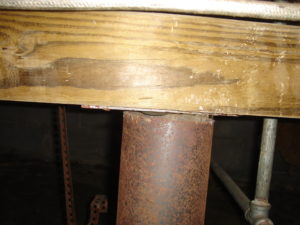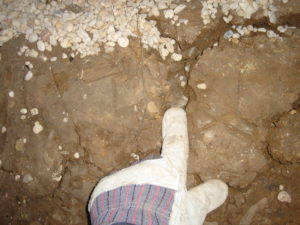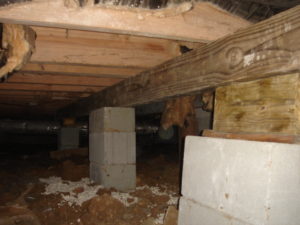
Although wood rot spores are not directly harmful to humans, they can contaminate the air in your home and may cause allergic reactions.
Wood rot, (known in some regions as dry rot) is a fungus that feeds on the lignin or cellulose in the wooden parts of your foundation.
Pier and beam foundations that form a “crawl space” beneath your home can be especially vulnerable to the effects of wood rot and moisture related wood decay.
How wood rot attacks your foundation and subfloor
Wood rot and wood decay often develops in hard-to-reach areas of your crawl space and can be aggravated or accelerated by excess water, moisture, or humidity that collects beneath your home.
These sensitive areas may include:
- Beams
- Joists
- Wooden pier extensions
- Sill plates (mud sills)
- Sub-flooring (especially where it meets joists)
- Framing around vents, doors, windows, or utility chases (where moisture can enter)
Any or all of these structural parts can lose load-bearing capacity even with a small amount of wood decay. The longer it goes unchecked, the worse the damage can get. If your pier and beam foundation was built using older untreated wood, your risk of wood damage may be even greater.
How to recognize wood rot in your crawl space
An occasional do-it-yourself inspection with a flashlight may be enough to detect the presence of wood rot, but if you’ve had unusual weather or flooding events or a serious plumbing leak, it’s a good idea to have a foundation expert do a professional evaluation. Here are the most common warning signs th
- A powdery or foamy buildup on wood components, especially where materials meet
- White, yellow, or brown discoloration on subflooring, beams, or joists
- Signs of accumulated moisture, condensation, or standing water where it shouldn’t be
- Gaps where unwanted water or humidity could enter your crawl space
- Interior floors that develop new sags or a “spongy” or “squishy” feel
- Musty odors that won’t go away
How to protect your crawl space from wood rot
Prevention is the most effective way to protect your home from wood rot and the risk of foundation damage. Here are low-cost or no-cost homeowner tips you can apply to keep wood rot out of your crawl space:
- Use a commercial subfloor sealing product like LumberKote to make exposed wood water resistant
- Keep your rain gutters and downspouts in good repair
- Inspect your crawl space at least once a year for signs of excess moisture
- Check seals around your crawlspace and plug gaps where moisture can enter
- Build up the grading around your foundation so water drains away from the house

Fortunately, there are ways to protect and restore your crawl space to like-new condition that will fit almost any budget and individual situation.
- Crawl space encapsulation
- Dehumidifiers and temperature control
- Structural repairs using new wood or steel components
- Drainage enhancements
- Sump pumps
Olshan has been protecting homeowners with professional foundation repair services since 1933. If you have any questions about wood decay or crawl space protection, one of our expert team members would be happy to talk with you and provide a free, no-obligation evaluation.
